XR & Monarch logos (2019)
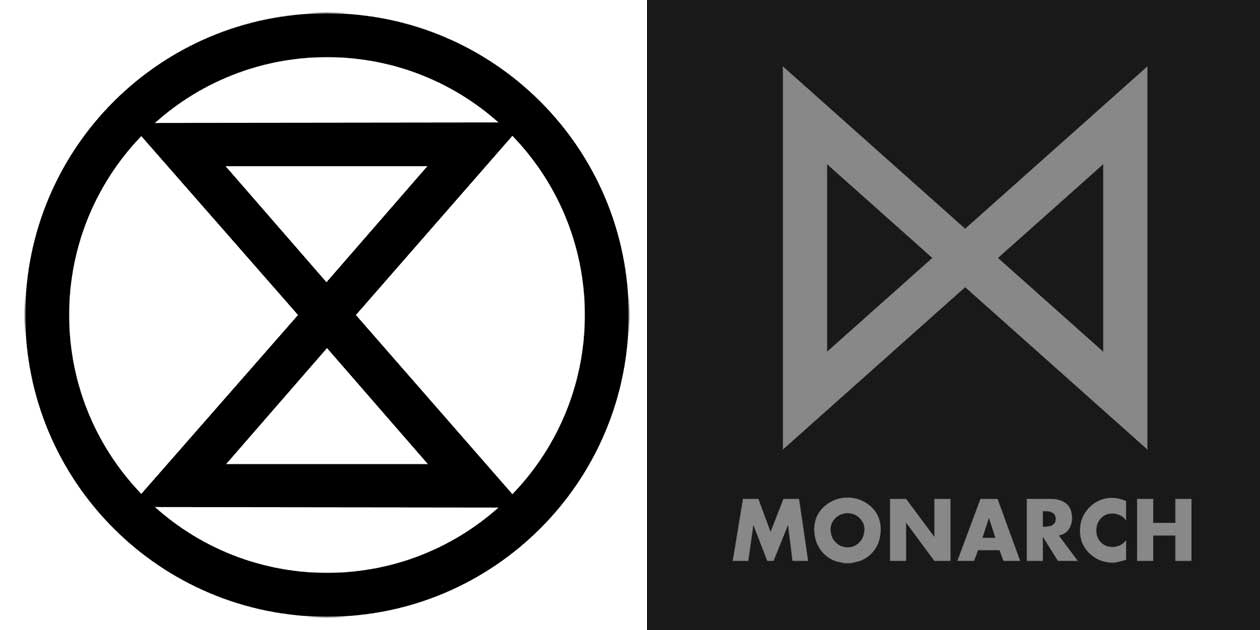
NB: Thanks to doop for pointing out that the logo for the Extinction Rebellion movement was designed in 2011 by East London artist Goldfrog ESP, and that it is Legendary Pictures that has turned the logo on its side, not the other way around.
For more info: https://www.logodesignlove.com/the-extinction-symbol
I am a supporter of the Extinction Rebellion movement (XR), but as a designer, I have misgivings about their logo. According to Wikipedia the circle in the XR logo ‘signifies the planet, while the hourglass inside serves as a warning that time is rapidly running out for many species.’
I think that there is a striking similarity between the Extinction Rebellion movement logo and the logo of the Monarch organization. This ‘Monarch’ was created by Legendary Pictures and appeared in the 2014 Godzilla film, and more recently in Kong: Skull Island. I understand that one is an hourglass and the other probably a butterfly, but there is something unsettling when you see them side-by-side.
Jim and I (2019)
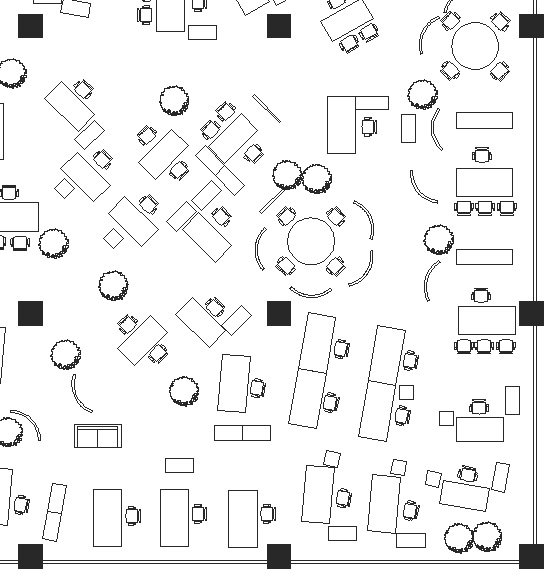
My bank went through a rejuvenation treatment also known as a ‘renovation.’ The contractors worked mostly at night and then, the bank closed altogether for a few days. When it came back into the physical world, it was as an open-concept entity.
As far as transformation goes, this was an important re-emergence. The bank is more spacious and brighter, with little restaurant-booths-like stations on the side. I like to think that customers could sit there to dream of cheesecakes and other delights. The only thing missing, it seems, is a Ping-Pong table. But as I waited in line, yes there is still a queue area – a difficult concept to fathom in an open-plan design, I started to think of how strange the whole thing is. What is this openness all about? Is the bank really open, or does it just feel open?
Banks have always thrived on the idea of privacy, of cubicles, of safety deposit boxes and even if the appearance of the bank happens to change, the invisible walls are probably as thick now as they were before. It probably boils down to simple economics; fewer wall surfaces and less maintenance might translate into more profits. All of the above advantages come into play without mention of the fact that an open banking surface becomes easier to monitor. In fact, my bank’s openness might be closer to Jeremy Bentham’s Panopticon than to Frank Lloyd Wright’s pioneering open-plan designs, which “represented the promise of a new social ideal […] that would […] allow egalitarian integration”.[1]
But now, why would a bank – not the most benevolent entity in the world – care about egalitarian integration? I think that by opting for an open-plan layout, my bank was hoping for a magical, sympathetic effect; that seeing the openness of the space; we could automatically assign these perceptions to the bank itself. In short, that we could believe that the bank is as open, generous and honest as the space it occupies.
So here it is, my new bank, based on the foundation of my old bank. A wolf dressed up as a grandmother has opened its doors to welcome me, to do business with me. I wait in a line that is as long as the one before. Then, I notice a smiling clerk getting up and walking toward me. “Hi, I’m Jim, how can I help you today.” It is nice of him to say that, but there is something artificial about our first contact, something uncomfortable. The script will be restated over and over in the coming weeks, months and years. No doubt, it will come to sound more natural. Meanwhile, Jim and I walk to his workstation where he opens his computer. I stand on the side, almost like being in a pub. As I enter my passcode, I realize that it signals the end of all openness. Night has suddenly fallen; the bright sunshine of my bank is no more. We are now moving in a closed-floor-plan, a world of encryption, firewalls and privacy screens.
[1] The Curse of an Open Floor Plan, The Atlantic, Ian Bogost, May 17, 2018
https://www.theatlantic.com/family/archive/2018/05/the-curse-of-an-open-floor-plan/560561/
Nationalization (2018)
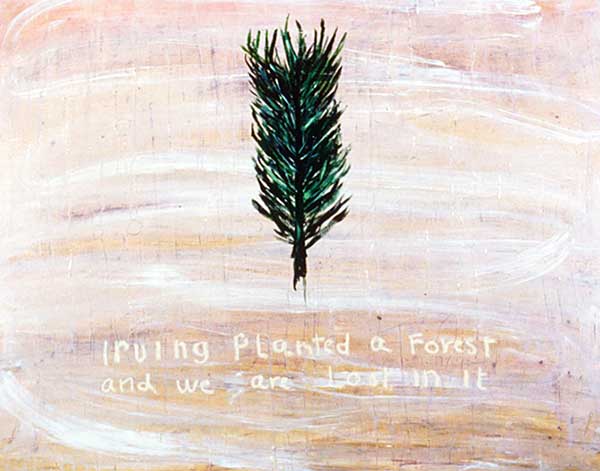
Painting by Daniel H. Dugas, 1997.
In this New Brunswick election campaign period, we are bombarded with all kinds of promises from the leaders of the new-world-to-be, but I have not heard the following. What would happen if New Brunswick would nationalize its natural resources? Nationalization of natural resources has successfully taken place in the recent past; Norway nationalized its oil, and Québec nationalized its electricity. As Irving is involved in so many sectors of New Brunswick life, it might be more efficient to assume control or ownership of the Empire itself.
The Irving entity is the third richest in the country. It is perhaps ironic that it is based in New Brunswick, a province recognized as holding one of the lowest gross domestic product ratings in Canada. It is perplexing how one of the poorest provinces in the country has produced one of the richest entities and it brings the question of whether the wealth of the former is related to the difficulties of the latter.
In any case, the Irving Empire is vast and might be considered to be a form of cancer. We all know someone who had it; died from it or survived it, and we all know someone who works in one of Irving’s invasive ventures. We fill our cars with Irving gas, we live in their prefab homes, read their newspapers, use their tissue products and sometimes, we go out to enjoy the parks that they have created to protect “environmentally significant areas.” [1] And as if this were not enough, we are also footing the bill to spray glyphosate on crown lands [2] to create monocultural forests to make Irving’s tree harvest easier and more profitable. Profits aside, the regular spraying of this chemical alone is reason for concern.
This mighty empire is comprised of the following: Irving Pulp & Paper Ltd., Irving Paper Ltd., Irving Tissue Co. Ltd., Lake Utopia Paper, Irving Sawmill Division, Irving Woodlands Division, New Brunswick Railway Co. Ltd., New Brunswick Southern Railway Co. Ltd., Eastern Maine Railway Co. Ltd., Maine Northern Railway Co. Ltd., Midland Transport, Midland Courier, RST Industries, Sunbury Transport, Atlantic Towing, Kent Line, JDI Logistics, Universal Truck & Trailer, Harbour Development, Saint John Shipbuilding, Halifax Shipyard, East Isle Shipyard, Shelburne Ship Repair, Woodside Industries, Fleetway Services Chandler, Kent Building Supplies, Shamrock Truss, Irving Tissue (Royale, Majesta, Scotties, private labels), Irving Personal Care (diapers, training pants), Cavendish Produce (fresh vegetables), Cavendish Farms (frozen potato processing), Indian River Farms, Riverdale Foods, Atlantic Wallboard, Irving Wallboard, Gulf Operators, Irving Equipment (crane rental, heavy lifting, specialized transportation, pile driving and project management services), Kent Homes, Plasticraft, Personnel Services, Protrans Personnel Services Inc., Industrial Security Inc., Moncton Wildcats, Telegraph-Journal (Saint John NB), Times & Transcript (Moncton NB), The Daily Gleaner (Fredericton NB), The Tribune (Campbellton NB), La Voix du Restigouche (Campbellton NB), The Bugle-Observer (Woodstock NB), Le Journal Madawaska (Edmundston NB), L’Étoile (various editions), Édition provincial, Édition La Cataracte (Grand Falls NB), Édition Chaleur (Bathurst NB), Édition Dieppe (Dieppe NB), Édition Kent (Bouctouche NB), Édition Péninsule (Shippagan NB), Édition République (Edmundston NB), Édition Restigouche (Campbellton NB), Édition Shédiac (Shediac NB), Kings County Record (Sussex NB), Miramichi Leader (Miramichi NB), The Northern Light (Bathurst NB), Here (Saint John NB, Moncton NB, Fredericton NB).
What would happen if all of this would be nationalized? The answer is that it wouldn’t be quite the same.
[1] Our Nature Parks and Nature Education Programs
https://www.jdirving.com/jd-irving-sustainability-nature-parks.aspx
[2] Stop Spraying NB:
http://www.stopsprayingnb.ca/
For more info:
Provincial and territorial natural resource indicators, 2009 to 2016:
https://www150.statcan.gc.ca/n1/pub/13-604-m/13-604-m2018088-fra.htm
List of Canadians by net worth :
https://en.wikipedia.org/wiki/List_of_Canadians_by_net_worth
Nationalization: Advantages and Disadvantages of Nationalization:
https://www.importantindia.com/15749/nationalization/
Oil together now: Lessons on nationalisation from Norway:
https://mg.co.za/article/2011-09-08-oil-together-now-nationalisation-lessons-from-norway/
Common Interest (2018)

Commonwealth Games: medal table for Gold Coast 2018: https://www.theguardian.com/sport/ng-interactive/2018/apr/05/commonwealth-games-medal-table-for-gold-coast-2018
Looking at the results of the recent Commonwealth Games, I don’t know if I should be amazed, shocked, or outraged by the medal count. For example, Australia, a country of almost 25 million people, got three times more medals than India, a country of 1 billion, 300 million people. In other words, India, a country with a population 52 times bigger than Australia finished the Games with 132 fewer medals than Australia. One might conclude that the athletes from Australia are either born with superpowers, an impossible and racist conjecture or else there is a political will and economic policies to sustain and elevate levels of athletic prowess Down Under. The gap between winners and non-winners begins to look like a canyon with the seven nations of Australia, England, Canada, New Zealand, Wales Scotland, North Ireland and the Isle of Man winning a total of 565 medals. The other sixty-four participant nations took away 234 medals, that count includes the total medals won by the sum of participating African nations.
If the Commonwealth is the traditional English descriptor for a political community founded for the common good, I wonder what is the common wealth at play here. It is certainly not embodied in the haul of medals that are awarded to the best of the best. What we are seeing in competitions like the Commonwealth Games, even more so than in the Olympic Games, is a visualization of international inequalities.
When we talk about fair games, the usual common topic is anti-doping criteria. There are clean and not-so-clean participants, but chemical enhancements are not the only kinds of boosts that can propel your average sprinter. Wealth is a marker that could be used to identify the possible ability, success, and/or failure of a participant or nation. Perhaps the Gini index which looks at wealth distribution of a nation’s residents to measure inequalities could be tailored to test athletes, not for prohibited chemical enhancements, but to quantify economic advantage.
See also:
DEMOS / The Racial Wealth Gap: Why Policy Matters
http://www.demos.org/publication/racial-wealth-gap-why-policy-matters
Handicap (golf)
https://en.wikipedia.org/wiki/Handicap_(golf)
The Ghost in the Machine (2018)

While the airwaves are filled with news that computers are vulnerable to the Meltdown and Spectre attacks, something incredible happened deep inside my own Yamaha synthesizer.
I have been playing on this keyboard since 2002 without a glitch. Last year, after a gig, I mentioned to someone that my synth was a workhorse; after fifteen years of composing and playing music, it was still going strong. That must have been the signal for something to go wrong. Suddenly, the up and down arrows stopped working. Without these, I lost access to crucial functions in my workstation. I contacted a local electronic service center and brought the keyboard in for an emergency visit. The technician found that one of the PCM boards was not working and a replacement part was purchased from Japan. After weeks of waiting, the part finally arrived and the keyboard was healed. This renewed vitality was more like a short remission as the arrows soon lost their power for a second time. I brought the keyboard back to the shop but nothing else could be done. My beloved sound-making machine looked like it would never be the same.
The keyboard still worked, it just wasn’t what it used to be. As time went on, I learned how to live within its reduced capabilities. Then a few days ago, I turned it on, selected the piano voice and started to play, but the machine seemed to have another idea in mind. It kept cycling through voices and parameters. The yellow, red and green lights on the controls were flashing on their own. I tried to regain control but was unable. In desperation, I hit the surface of the keyboard with my fist to power it off. I thought this could be the death rattle of it, the end of music.
I waited a few seconds and turned it on again. The lights flashed once more, the names of voices on the LED window kept cycling around and around. And then, all of a sudden, all of that madness stopped. I looked at the keyboard as if it was a wild animal, unsure if it was going to jump at me or burst into flames, but nothing happened. I touched the keys; the piano was there. I played a little something. Everything sounded okay. Then I noticed that the up and down arrows were working! I played some more, accessing things that were not optional since the breakdown. I was shocked. I thought that these reemerging sounds might be the last to come out of my machine; if I closed it, it might die. I was afraid to power it off, so I played all day thinking that it was the last day.
Then, at some point, when I was ready, I shut it down. I waited a few minutes and put it on again. It was still working, and it is still working now, days after the incident. I don’t know what happened, maybe the ghost in the machine decided to make a move, or a speck of micro dust stuck under something fell off when I hit the keyboard. What do I know of the secret lives of microprocessors? Maybe I will never know, but for the time being I am ecstatic, enjoying the return of the way things were.
The bus route (2017)

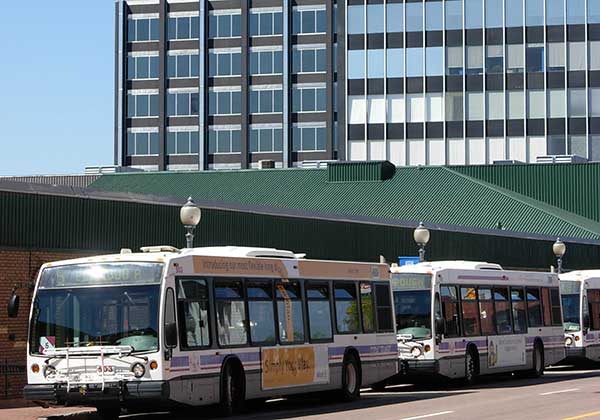
Sometimes waiting for a bus in a small town takes courage. That day, we were the only ones at the bus stop, which is not a good sign. The size of the crowd is like a measuring cup. The more people at the shelter, the closer the bus and inversely, the fewer people, the farther the bus, the longer the wait. On that day we were the only ones and we were hoping for the best: for the exception to the rule. The sun went down and the northern night came with her big coat. Just as we were wondering if buses were still coming to this bus stop, a pickup truck stopped in front of us with its window sliding down. A quick glance at the truck door revealed that it belonged to the City’s transit department. The driver was leaning toward us, his body language was telling us that he wanted to say something. We approached. The man explained that an accident on a main street was blocking any buses from coming to our location. To our surprise, he offered to drive us home.
John was his name. He had been a bus driver with the City for 35 years and was now in charge of the logistics of moving people. He said that the accident had happened hours ago and police were still busy at the scene. He said that his job was to try to keep the system on time and picking people here and there at any congestion points was actually the best thing to do. John was driving very slowly. The heat was on. It was definitely a comfortable ride. We followed the same route as the bus would have taken and stopped near our home. We thanked our driver for his help.
Sometimes waiting for a bus in a small town takes a lot of courage, but occasionally something unexpected happens, something that could only happen in such a place.
Daniel H. Dugas
November 2, 2017
Image: By Stu pendousmat at English Wikipedia, CC BY-SA 3.0, https://commons.wikimedia.org/w/index.php?curid=13114323
Everything is relative, connected or disconnected (2017)
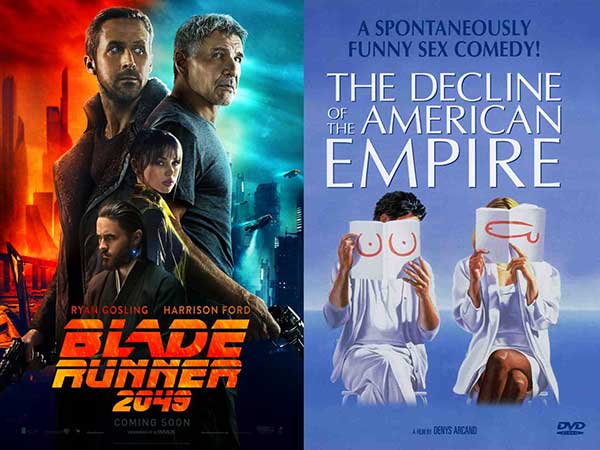
In September 1986, while in Vancouver for the Expo ‘86, I went to see Le Déclin de l’empire américain. [1] The theater was half full and the audience was comprised mainly of young people in their 20’s, like me. ‘A spontaneously Funny Sex Comedy!’ was the then tantalizing tagline for the movie’s Canadian release in June. As the movie progressed, the young people started to leave the theatre, one by one, two by two. I also wanted to leave, but stayed until the end, as I became more interested in witnessing the mass evacuation than seeing the conclusion of the movie itself. What I witnessed was a profound lack of interest. It did not matter because the movie went on to be shortlisted at the Oscars for best foreign film. Nor does it matter that it has remained one of the great films realized by Québec Director Denis Arcand. Many years later, I saw the movie again. The images of the exodus I witnessed during its debut still stood out for me as stronger than the film itself.
Blade Runner 2049 seems to have something in common with Le Déclin that I saw. On the opening weekend 2049 it became a box office flop. Commentators are saying that something didn’t click with audiences. [2] It reminds me of the crowd of young people in the Vancouver cinema. But, everything is relative, and Blade Runner 2049, like Le déclin will not rely on reactions of audiences to gauge its greatness. It could still become a cult favorite.
[1] The Decline of the American Empire – On this occasion in Vancouver, the film was presented in French with English subtitles.
[2] Why Blade Runner 2049 is a box office flop
http://www.nzherald.co.nz/entertainment/news/article.cfm?c_id=1501119&objectid=11930950
The Power of Outrage – ‘Anger is an Energy’ (2017)

I was invited through the Regroupement des éditeurs canadiens-français (RECF) to take part in two events in this year’s Burlington Book Festival. The first event Text(e)/Image was a performance with Herménégilde Chiasson at the Contois auditorium. The second event was called The Power of Outrage, a panel discussion with Shenaaz Nanji, Mary Dingee Fillmore, Leda Schubert, Melissa Febos and myself. It was moderated by Cora Siré. The discussion was centered around the question of ‘What fuels writers to take on burning issues? How do they handle the political? Does writing give them refuge from despair?’
I think that writing is a way to make sense of the world that exists around us. That is probably the main reason why I write and because the world is always moving, always transforming, the situation is always new and the need to understand it never-ending. My practice is multidisciplinary but economy and the political economy of our world is something that I continue to visit and to revisit. I believe that this is the foundation of societies; an uneven field. During the panel, I spoke about the vast empire created by Irving and our dependencies as citizens in New Brunswick, Canada. I spoke about glyphosate, ‘an herbicide sprayed throughout New Brunswick’s forests to kill hardwood growth’ [1] and the surrealistic battle forcing citizens of Moncton to demand that the spraying by J.D. Irving near Greater Moncton’s drinking water supply be halted. [2] The chemical itself is actually paid by the Province of New Brunswick, a practice that maximizes the profit margin of Irving. To me, this is a proof of whom is in charge. Obviously, the taxpayers are not, because we are forced to demand for the discontinuation of a practice that is polluting our forests, our groundwater and our very drinking water itself.
On my way back home, driving through Vermont, New Hampshire, and Maine, I had time to think more about the panel. There are a few things that I wanted to say but they did not surface. In the last few years, our feelings as a society towards outrage have changed. Even Facebook now recognizes the importance of anger as normal, or at least a possible reaction.
If, for Facebook, anger is data to tailor a more personalize experience for its users, it can be form of energy to others.[3]
Anger Is An Energy, like the lyrics of Johnny Rotten’s song states. It can force someone to take a stand, to make a point in the hope of making something better. But anger can be a difficult road and sometimes, it can only take you so far. To be angry is to give out sparks, to shed light where it is often needed. The outrage must be voiced but it demands an enormous amount of energy. It can suck the light out of the room, the sanity out of an individual. To be distressed and in pain all the time cannot be healthy for anyone. This is why it has to be dealt with extreme care.
Driving through the Green Mountains of Vermont, the White Mountains of New Hampshire and into the forests of Maine gave me enough time to ponder about anger, its potential and its drawbacks. Yes, anger is an energy with dangerous currents, but it can also be a form of resistance that can protect individuals from getting electrocuted by the aberrations of the world.
[1] California places popular N.B. herbicide on list of cancer-causing chemicals http://www.cbc.ca/news/canada/new-brunswick/gylphosate-herbice-new-brunswick-california-1.4182805
[2] Moncton mayor calls for halt to glyphosate spraying inside city’s watershed https://globalnews.ca/news/3694180/moncton-mayor-calls-for-halt-to-glyphosate-spraying-inside-citys-watershed/
[3] Facebook’s Five New Reaction Buttons: Data, Data, Data and Data http://www.slate.com/blogs/future_tense/2016/02/24/facebook_s_5_new_reactions_
buttons_are_all_about_data_data_data.html
We all want the same thing: to leave our children and our children’s children a better community. (2017)
We all want the same thing: to leave our children and our children’s children a better community: Environment/ City of Moncton: Reducing our environmental footprint [1]
The City of Moncton can do great things. The new Rabbit Brook Trail that goes from Mapleton Road to Reade Street Park is a perfect example of this desire to create a better community.[2] Moncton even has a plan to reduce our environmental footprint. The page on the City of Moncton’s website states that ‘Moncton is a city whose residents believe in sustainability, creativity, and leadership …’ and ‘that fewer cars on the roads mean cleaner air.’ The obvious question is how we are going to achieve this lofty goal with events glorifying vehicles that are notorious for polluting the atmosphere? The cars in the Atlantic National, which is happening right now, are known polluters with extremely high emissions. What is the toxic legacy that is left by the 2000 + cars coming into town every year for this event? Is this part of the ‘children’s children’s better community’? As a pedestrian in the city, I can attest to the difficulty of walking in noxious fumes during this celebration.
And it is not just the Atlantic Nationals filling the air with this rich fuel mixture. Moncton is also home of the Greater Moncton Corvette Club Show & Shine; the Annual Mustang Club Car Show and, of course, the Atlanticade Motorcycle Festival. How many motors will it take for our city to be truly green?
I understand the importance of commerce and having a place where everyone can live their lives, but if we continue to host such damaging environmental events, we should be conscious of our actions. First, we should cross out the line on the City’s website that states ‘… fewer cars on the roads mean cleaner air’, as this is a misleading statement in view of these featured auto events. The second thing that we could do is to perhaps invite one of the Volkswagen executives who ‘pleaded guilty to conspiracy and obstruction of justice charges to get around US pollution rules on nearly 600,000 diesel vehicles by using software to suppress emissions of nitrogen oxide during tests’[3] to be the grand marshal of one of the car exhaust festivals.
Daniel H. Dugas
7 July 2017
[1] ‘We all want the same thing: to leave our children and our children’s children a better community.’ from: Environment/ City of Moncton: Reducing our environmental footprint
https://www.moncton.ca/Residents/Environment.htm
[3] Volkswagen pleads guilty to all criminal charges in emissions cheating scandal, The Guardian, 10 March 2017.
https://www.theguardian.com/business/2017/mar/10/volkswagen-vw-pleads-guilty-criminal-charges-emissions-cheating
There’s no place like home (2017)

Finally, a feel-good story from the East! Moncton is “the place to be,” [1] says Canadian travel blogger Andrew Gunadie – Hurray! Down here, we all know that we live in a special place and I recently heard it said that ‘There’s the good times, the bad times and the Maritimes!”
But let’s start with a bit of background information. The first and the most famous travel writer was Herodotus, the Greek historian who lived in the fifth century BC. The role of any travel writer, he said, “is to be the tourist’s perfect companion: to be articulate, well informed, a skilled raconteur; to include in what he tells [sic] a fair share of the unusual with a dash of the exotic; to tell it all with infinite zest.” [2] Gunadie has many of those qualities, he is articulate, engaging, charming, and I want to believe him. But there is something in his travel truth that made me pause. To say that the City of Moncton is the ‘place to be’ or not, is not the aim of my commentary. I am curious about the tone, the coverage of his story and ultimately what it says about us.
When I first saw Gunadie’s video, I was delighted. Imagine, my hometown was the best place to be! Joy! My second impression was more nuanced. There is something steering the clip that reads like an advertisement. Maybe the ‘place to be’ reminded me of the infamous New Brunswick licence plate tagline, the “Be … in this place”.[3] I understand the necessity of naming things (cafés, pubs and restaurants), of speaking in clichés or memes (beach for oneself, beautiful sunset), but I believe that it is possible to write about a place without sounding like an ad.
A lot of travel writing is about selling something to someone, but it does not have to be like that. Jack Kerouac’s On the Road and Ernesto Che Guevara’s The Motorcycle Diaries are examples of two great works based on actual travel adventures. The genre continues to reinvent itself. In December 2016, Canadian Art Magazine awarded its Art Writing Prize to Calgary Art Critic, Ginger Carlson for her travel essay describing “a journey with artist Nicole Kelly Westman to former mining town Wayne, Alberta, to produce a new work.”[4]
The script of Our Country: Gunnarolla on why Moncton is his favourite place could have been lifted from a Tourism New Brunswick brochure. It is all niceties, product-oriented and we heard it before:
The East Coast is where the friendliest people live
Does anyone do seafood like the East Coast of Canada?
Moncton is perfect for road trips
Having a beach for oneself
Amazing sunsets
Walking ‘on the ocean floor’
This ‘walk on the ocean floor’ has been repeated like a mantra by the operators of the Hopewell Rocks as well as by the New Brunswick Department of Tourism.[5] It is probably something that everybody in New Brunswick does in his or her sleep, but to talk about Hopewell Rocks without mentioning the recent collapse of the Elephant Rock, one of the more popular of the Flowerpot formations, is puzzling. Gunardie surely wants to focus solely on the positive.[6]
The suspension of my belief came in a two-pronged realization. The first prong happened last month when the New Brunswick Department of Tourism announced that it was investing $1.1M for travel writers to promote tourism over the next 4 years[7]. Could this Canadian Geographic feature be part of that program? The second prong came a few days ago, when CBC New Brunswick published an article about Gunardie’s video. When I saw the video on Facebook, I thought that it walked like an advertorial and it talked like an advertorial, so I thought that it was an advertorial, but it did not trouble me, as after all, it was on Facebook. But to see it on CBC News was like seeing a little red flag on the horizon. The question is, why would CBC News would cover an ad? It is important to distinguish between the genuine article and the advertorial. Otherwise, we should have news stories about Leon’s couches.
How we see ourselves is important to consider, how other people see us might be more crucial. Our enthusiastic reaction to the Gunardie’s story is natural, but our social identity and the positive emotions we experience from belonging to any social group, or place, must not be shaped by marketers alone. The book has already been written, it’s called: Tourism Marketing for Cities and Towns and chapter 3: Analyzing the City or Town as a Tourism Product offers food for thought.[8]
Daniel H. Dugas
Moncton, NB
[1] “Travel blogger says Moncton is ‘the place to be’,” last modified Feb 24, 2017, http://www.cbc.ca/news/canada/new-brunswick/blog-travel-gunnarolla-moncton-nb-favourite-1.4008283
For an interactive map of « Our Country » see Canadian Geographic, last modified Feb 24, 2017, http://maps.canadiangeographic.ca/our-country/map.asp
[2] Lionel Casson, Travel in the Ancient World, (Hakkert, Totonto, 1974), 111
[3] “N.B. dumps licence plate slogan”, last modified Feb 24, 2017, http://www.cbc.ca/news/canada/new-brunswick/n-b-dumps-licence-plate-slogan-1.1089931
[4] “Calgary Critic Wins Canadian Art Writing Prize”, last modified Feb 24, 2017, http://canadianart.ca/news/canadian-art-writing-prize-winner-announced/
[5] Tourism New Brunswick, Walk on the ocean floor, last modified Feb 24, 2017, http://www.tourismnewbrunswick.ca/Products/ECs/WalktheOceanFloor-The-Hopewell-Rocks-EC.aspx
[6] “New Brunswick’ s famed Elephant Rock collapses in a pile of rubble”, last modified Feb 24, 2017, https://www.thestar.com/news/canada/2016/03/15/new-brunswick-s-famed-elephant-rock-collapses-in-a-pile-of-rubble.html
[7] “Province pays $1.1M for travel writers to promote tourism over 4 years”, last modified Feb 24, 2017, http://www.cbc.ca/news/canada/new-brunswick/cash-coverage-tourism-vacation-1.3991776
[8] Bonita Kolb, Tourism Marketing for Cities and Towns: Using Branding and Events to Attract Tourists, (Routledge, 2017). https://www.routledge.com/Tourism-Marketing-for-Cities-and-Towns-Using-Social-Media-and-Branding/Kolb/p/book/9781138685192
For Analyzing the City or Town as a Tourism Product, see Chapter 3 in Google Books, last modified Feb 24, 2017, http://bit.ly/2n6NjDm
Daniel H. Dugas
Archives
Blogroll
- A.I.R. Vallauris
- ACAD
- Adobe additional services
- Adobe Creative Cloud
- AIRIE
- Amaas
- Amazon Author Central
- ARTothèque
- Australian Poetry
- Basic Bruegel
- Bitly
- CCCA
- CDBaby
- Cycling 74
- Dissolution
- Éditions Prise de parole
- Emmedia
- eyelevelgallery
- FAVA
- Festival acadien de poésie
- Festival FRYE Festival
- FILE – Electronic Language International Festival
- Freeware list
- Fringe Online
- Galerie Sans Nom
- Gotta Minute Film Festival
- Instants Vidéo
- JUiCYHEADS
- Kindle Direct Publishing
- Klondike Institute of Art and Culture
- La Maison de la poésie de Montréal
- La Maison de la Poésie et de la Langue française Wallonie-Bruxelles
- Laboratorio Arte-Alameda
- Le Centre Jacques Cartier
- Liberated Words
- Maison Internationale de la Poésie – Arthur Haulot
- MediaPackBoard
- Miami Book Fair International
- Monoskop
- Mot Dit
- NSCAD University
- Paved Arts
- PoetryFilm
- Portail des auteurs du Nouveau-Brunswick
- RECF
- Revue Ancrages
- Salon du Livre du Grand Sudbury
- Sculpture Space
- Subtropics.org
- Sydney college for the arts
- The Centre for Contemporary Canadian Art
- The New Gallery
- Trevigliopoesia
- tumbler-documents
- V Tape
- Valerie LeBlanc
- VideoBardo
- Void Network-Κενο Δίκτυο
Categories
- #covidpoèmes
- Advertisement
- AIRIE
- Ancrages
- anthology
- Anthropocene
- Architecture
- Around Osprey
- art
- Article de presse
- arts visuels
- audio
- Australian Poetry
- Basic Bruegel Editions
- Book
- book fair
- Cafe Poet Program
- Ce qu'on emporte avec nous
- Citations gratuites
- Collaboration
- commentaire
- commentary
- Compte rendu
- conférence
- Conservation Foundation of the Gulf Coast
- COVID-19
- Critique littéraire
- culture
- Daniel Dugas
- Design
- Édition Michel-Henri
- Éditions Perce-Neige
- Éloizes
- Emmedia
- emoji etc | émoji etc
- Environnement
- essai
- essay
- Everglades
- Exhibition
- festival
- Festival acadien de poésie
- Festival Frye Festival
- FIPTR
- Flow: Big Waters
- Fundy
- Habitat
- installation
- Instants Vidéo
- interactivity
- journal
- JUiCYHEADS
- Kisii
- L'Esprit du temps
- laptop
- Leaving São Paulo
- lecture
- Livre
- logos
- Magazine
- Miami Book Fair
- Moncton 24
- novel
- OASIS
- oil spill
- perception
- performance
- Photo
- poésie
- Poetic Licence Week
- Poetry
- politics
- politique
- press
- Prise de parole
- Revue Ancrages
- salon du livre
- sculpture
- Sculpture Space
- sound
- Souvenirs
- Spirit of the Time
- Style & Artifacts
- Symposium d'art/nature
- talk
- television
- The New Gallery
- Uncategorized
- Valerie LeBlanc
- vidéo
- vidéopoésie
- Videopoetr/Vidéopoésie
- videopoetry
- visual arts
- What We Take With Us
- youth literature








